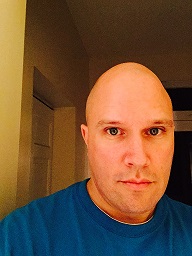AUTHOR PROFILE
Daniel M. Shapiro ([email protected]) is a special education teacher who lives in Pittsburgh. His recent book of poems, How the Potato Chip Was Invented, was published by sunnyoutside press. His poetry website is Little Myths (http://littlemyths-dms.blogspot.com/).
|
I write primarily to express myself. My past as a journalist and advertising copywriter seems to make my poems different from those written by people with poetry backgrounds. I work a lot of biography (or invented biography) into my writing and often present popular culture phenomena as allegory. I am influenced by other poets who do this, though not many do, and they are often criticized for doing so. Many critics and other writers consider pop culture to be low culture, so they try to avoid it. I like to write poems about what I know, and I have always been interested in knowing things like who played drums on “Land of 1,000 Dances” or which Burt Reynolds movie has a cameo by a teen-age Kevin Bacon (Roger Hawkins and “Starting Over,” respectively). The challenge is to write something meaningful with that mindset and what might seem like useless knowledge. I enjoy that challenge.
What other creative activities are you involved in?
I used to play instruments, draw, and paint, but I haven’t participated in creative activities other than writing lately. I enjoy being part of an artistic community through poetry. I was never good enough at my other creative pursuits to have been able to participate in a community.
Who is your favorite author and why?
It’s hard to pick one author. I like writers who take risks. Even a best-seller such as “Gone Girl” is a risky novel because of how the author, Gillian Flynn, has written the first half. I don’t want to give away what happens, but I actually quit on that book twice but was persuaded to stick with it. I am amazed it didn’t flop because of that first half, but the writer clearly knew what she was doing despite what I consider to be continual danger of losing readers. I just read Jim Thompson’s book “A Hell of a Woman,” in which the protagonist has a breakdown in the end, and his narration is split into two voices. For 1950s pulp fiction, that’s a pretty daring concept. Recently, I read Yannick Murphy’s “This Is the Water,” a mystery/crime novel written in the second person. She turns the reader into a character and uses a lot of repetition that could be off-putting for some. I found the book ideally disorienting.
Tell us about the mechanics of how you write.
As a journalist, I would sometimes go to a concert at night and write a review that would appear in the next day’s paper. To get that done, I would have to write the review in my head on the way back to the newsroom. I tend to write poems in a similar way, with only a handful of concrete ideas to start with. First I have the theme I want and maybe a few phrases (which I sometimes save as notes in my phone). Then I sit down and write a draft that incorporates the theme and phrases. I have had times when the poems just pour out, when I haven’t had to make many edits. Other poems I’ve had for years and continue to revise.
Finally, what do you think about Carp, the fish, not our website?
I have had a good relationship with carp over the years. As a Jewish kid, I remember eating gefilte fish every year during Passover. Gefilte fish is carp that’s ground up and shaped into patties. It disgusts many people. Everyone I know hated gefilte fish. I was the only one who loved it, so I always got to eat a lot of it. It’s a food that takes risks.

